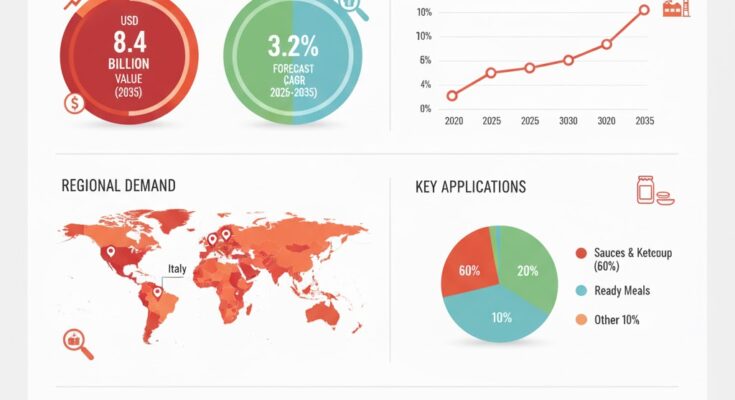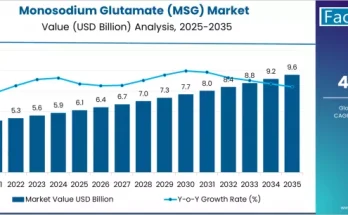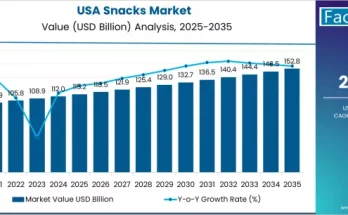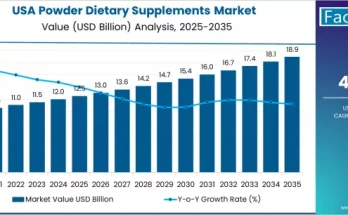The global tomato concentrate market is poised for steady growth, propelled by increasing consumption of processed foods, growing demand for natural flavor enhancers, and rising adoption of clean-label ingredients. According to a recent report by Fact.MR, the market is valued at USD 6.1 billion in 2025 and is projected to reach USD 8.4 billion by 2035, reflecting a CAGR of 3.2% during the forecast period. This represents an absolute increase of USD 2.3 billion over the next decade.
Tomato concentrate a vital ingredient in sauces, soups, ready-to-eat meals, and beverages—continues to gain traction as consumers seek convenient yet nutritious food options. The product’s extended shelf life, robust flavor profile, and versatility in culinary applications make it a cornerstone of the global food processing industry.
Market Drivers: Convenience, Clean Labeling, and Culinary Versatility
Rising Processed and Ready-to-Eat Food Consumption
The global surge in processed and convenience food demand, particularly in urban centers, is a key factor fueling tomato concentrate sales. Manufacturers rely on tomato concentrate as a cost-effective base for sauces, gravies, and ready meals, ensuring consistency and rich flavor across product lines.
Shift Toward Natural and Clean-Label Ingredients
Consumers are increasingly prioritizing clean-label products made from natural ingredients. Tomato concentrate, being free from artificial additives, aligns with this preference. The industry is witnessing a shift toward organic and sustainably sourced tomatoes, reflecting growing environmental and health awareness.
Global Culinary Integration and Export Growth
Tomato concentrate is central to cuisines worldwide—from pasta sauces in Italy and soups in the U.S. to curries in Asia. Expanding cross-cultural culinary trends and increasing exports from tomato-producing countries such as China, Spain, and the United States are boosting global market expansion.
Technological Innovations and Processing Advancements
Recent innovations in tomato processing technology have enhanced product quality, yield, and efficiency. Vacuum evaporation systems, aseptic packaging, and energy-efficient concentration techniques are minimizing nutrient loss while maintaining color and taste integrity. Moreover, automated production lines and advanced preservation methods are extending product shelf life and reducing wastage.
Competitive Landscape
The tomato concentrate market is moderately consolidated, with key players focusing on production efficiency, quality improvement, and regional expansion. Strategic alliances, capacity expansions, and sustainability initiatives are shaping competitive dynamics.
Key Players in the Tomato Concentrate Market:
- Morning Star
- Heinz
- Conesa
- Kagome
- Olam
- Mutti
- Dei Fratelli
- Chalkis
- Toma-Tek
- Sino Tomato
These companies are investing in advanced processing technologies, sustainable farming practices, and global distribution networks to strengthen their market position.
Recent Developments
- August 2025 – Mutti expanded its production capacity in Northern Italy with a new energy-efficient processing plant to meet rising global demand for tomato-based products.
- June 2024 – Olam introduced a sustainable sourcing program in India to enhance tomato yield and support local farmers with advanced irrigation technologies.
- February 2024 – Kagome launched a premium organic tomato concentrate range targeting European and North American consumers seeking clean-label, non-GMO ingredients.
Future Outlook: Toward Sustainability and Nutrient Retention
The next decade will see the tomato concentrate industry pivot toward sustainability, product innovation, and digital supply chain integration. Key trends include:
- Organic and Non-GMO Expansion: Growing preference for pesticide-free tomato concentrates.
- Sustainable Sourcing: Investments in water-efficient and renewable farming methods.
- Enhanced Nutrient Preservation: Advanced concentration technologies to retain lycopene and vitamins.
- Smart Packaging: Aseptic and recyclable packaging solutions extending shelf life and reducing environmental impact.
By 2035, the tomato concentrate market will continue to evolve as a cornerstone of the global food industry, meeting the dual demands of convenience and sustainability.



